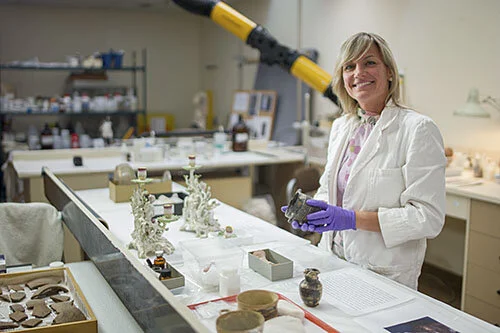Michelle Jacques
An interview with the Head of Exhibitions and Collections & Chief Curator at the Remai Modern in Saskatoon, Sask.
What is your job title and description?
As the Head of Exhibitions and Collections & Chief Curator at Remai Modern, I am responsible for setting the vision for the arm of the museum that develops exhibitions and looks after the collection. I manage a team of curators, exhibition managers, registrars and preparators. Together, we acquire, research, share and care for works for the museum. We also create, produce and present exhibitions, and strive to do so within a framework that engages the broadest public possible.
What career/educational path did you take to get here?
I studied art history with a focus on Canadian art and art criticism. I started working at the Art Gallery of Ontario in Toronto shortly after finishing my undergraduate degree. I worked in Membership, Volunteer Services and Human Resources before getting a job in the curatorial department. There, I worked in the Chief Curator’s office as well as the Prints & Drawings and Canadian departments, although most of my work has been in the area of contemporary art. This varied background put me in good stead for my most recent job as Chief Curator at the Art Gallery of Greater Victoria (AGGV). It’s been very useful to have an interest in and experience with a wide range of collecting areas and to have some understanding of how the rest of the institution works.
What is the most exciting part of your work?
The most exciting part of what I do is the range of people that I get to work with — artists, museumgoers, co-workers and other colleagues — all of the people who are part of the vibrant communities that are brought together through art. I studied art history at a time when it was believed that you couldn’t focus your studies on contemporary artists because you needed the critical distance of history to truly understand works of art. It was a stroke of luck for me to end up working in the contemporary field for so much of my career. I think working in the realm of contemporary art is such a gift; it is a privilege to be constantly challenged, inspired and transformed by artists and their work. It helps to keep my mind flexible. I have had opportunities to work with historical art, and I enjoy doing so greatly, but for me it is not primarily about the objects, but about understanding history through the narratives of the remarkable people who have left a cultural legacy in the form of artworks.
What is your biggest challenge?
For me, the biggest challenge of my work is overcoming the perception that art, and particularly contemporary art, is difficult to understand and elitist. So much of what we understand about history and previous civilizations is thanks to the cultural production of artists past. The artists of our time are creating visual records of the ideas, issues, philosophies and the problems that define our world. Curators — in collaboration with colleagues across the museum or gallery — serve to aid artists in the presentation of this work and to facilitate connections with viewers. The very function of my work is its greatest challenge then: Growing the range and number of people who connect to art. I believe wholeheartedly that all artists are, at their core, communicators, and that everyone has the right and ability to engage with art; even art that appears “difficult.”
Tell us a brief story about an object you have worked with.
The last acquisition I made at the AGGV, where I was the Chief Curator until January 2020, was a remarkable painting, Thunderstorm on Shuswap Lake, B.C., dated 1882, by an artist named Grafton Tyler Brown (1841-1918). Brown was an African American artist who lived in Victoria from 1882-1884. Brown grew up on the east coast of the United States and, at age 14, began working for a printer. In 1867, he opened his own lithography business in San Francisco. In 1882, Brown, who was fair in complexion, moved to Victoria, B.C. and reinvented himself, as a (white) painter. In order to gain access to the beautiful but remote sites of British Columbia, he joined the company of Amos Bowman Geological Survey. He made small sketches during his travels through the Okanagan Valley, the Similkameen, and the Fraser Valley. By 1883, Brown had completed a series of 22 paintings based on sketches from the trip which were exhibited in June 1883 in Victoria. It was a wonderful feeling to be able to add a work by a 19th-century Black artist to the AGGV collection.
Curator and writer Michelle Jacques was born in Toronto to parents of Caribbean origin who immigrated to Canada in the 1960s. She is currently Head of Exhibitions & Collection/Chief Curator at Remai Modern in Saskatoon, having joined the museum team in early 2021. Prior to that, she held the position of Chief Curator at the Art Gallery of Greater Victoria. Jacques also held various roles in the Contemporary and Canadian departments of the Art Gallery of Ontario, Toronto; was the Director of Programming at the Centre for Art Tapes in Halifax; and taught courses in writing, art history and curatorial studies at NSCAD University, University of Toronto Mississauga and OCAD University.
This article was published in the Spring/Summer 2021 issue of Studio Magazine.







